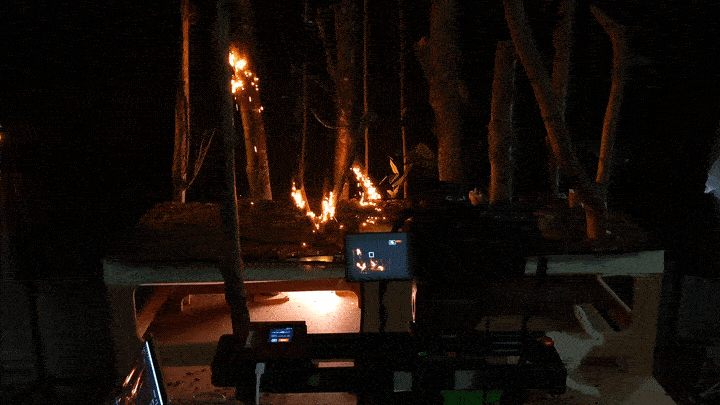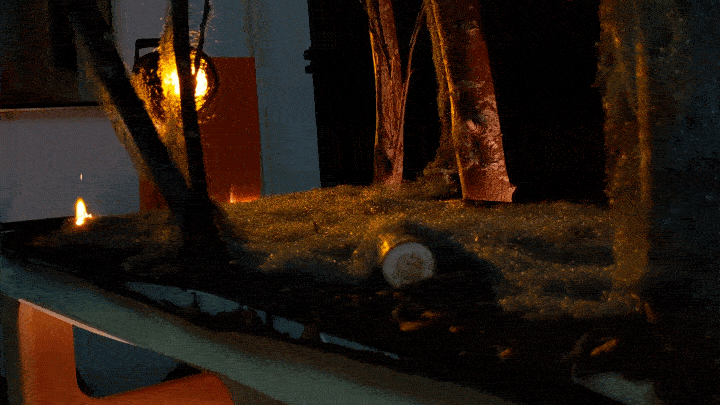How the WWF and NOMINT's sang a stop-motion song of ice and fire
After tackling a frozen stop-motion model for the WWF last year, directors Yannis Konstantinidis and Christos Lefakis went to the other end of the temperature scale for 2022's film, A Flammable Planet. We spoke to Konstantinidis about taming the elements, one frame at a time.
For most people, the sheer precision of stop-motion animation would be enough of a challenge to keep them occupied. Not so for NOMINT.
Following up last year's devastating Can't Negotiate The Melting Point Of Ice - an animated odyssey following a frozen polar bear - Yannis Konstantinidis and his team have gone to the other end of the elemental spectrum for A Flammable Planet, creating a film that utilises genuine flames to create a mesmeric (and terrifying) effect.
We caught up with Konstantinidis to find out why he was obsessed with making his animated life borderline impossible, and how his creative pain pays dividends for the charity it is in aid of.
Credits
View on- Agency Production Company In-House
- Production Company NOMINT
- Director Yannis Konstantinidis
-
-
Unlock full credits and more with a shots membership
Credits
View on- Agency Production Company In-House
- Production Company NOMINT
- Director Yannis Konstantinidis
Explore full credits, grab hi-res stills and more on shots Vault

Credits
powered by- Agency Production Company In-House
- Production Company NOMINT
- Director Yannis Konstantinidis
Last year was ice, this year it's fire. Do you like making life difficult for yourself?
Ha! If I had a penny for every time I’ve asked myself that! Last year’s repetitive sculpting process sent me to the operating table for tendonitis surgery and this year I got a second-degree burn.
Part of the idea of these projects, and what hopefully makes them stand out, is that the technique directly reflects the issue we are trying to communicate. Last year we were trying to show that once ice melts there is nothing you can do about it by building a set that was melting too fast to animate. This year, to show the uncontrollable and devastating nature of wildfires, we struggled with the real danger of combining live fire with a flammable set. The planet is in tremendous trouble and I wanted to make sure that the process of making these films reflects the underlying peril.
Last year’s repetitive sculpting process sent me to the operating table for tendonitis surgery and this year I got a second-degree burn.
On the other hand, from a purely technical point of view, these projects are also incredibly satisfying to produce. There is a pure sense of accomplishment that comes from nailing a shot that a few months earlier you would swear it is impossible to shoot. Of course, in hindsight, all the solutions seem obvious but at the time they were nothing but.
What was the brief from the WWF for this piece and how did you start putting it all together?
WWF has a continuous need for content that stands out, to communicate ideas that are urgent, important, and universal. The causes and effects of climate change are the most important issues for the planet and wildfires are both a cause and effect of climate change. WWF asked us to shed light on the issue and make a film that can cut through the noise.
WWF shows us incredible trust and creative freedom but we also work very closely with all their teams to make sure we communicate the concepts in the most effective way possible. The urgency of the matter doesn’t escape us, climate issues need to be resolved immediately and we need to do the absolute best we can to accurately and effectively communicate what’s crucial.
Above: Behind the scenes images from the film.
The film uses fire to an incredible effect. Can you talk us through the process of animating with actual flames and how that made a difference from your normal process?
We were adamant about shooting everything in-camera. After loads of testing we combined traditional stop-motion together with slow-motion, time-lapse, and long-exposure to show the different stages of the fire spreading, chasing, and eventually overpowering our hero.
We also relied on real fire, instead of artificial lighting, to light the rabbit and the set in as many shots as possible, which gave us a very interesting and unexpected effect but also doubled the time we needed to shoot every frame.
Did you have to do many tests to achieve the desired effect? What were some issues you ran into?
We experimented for about four months trying to figure out if this idea was even remotely possible.
We purposely had only one hero puppet which was progressively burned throughout the shoot.
Not surprisingly the biggest issue was that the set, props, and puppet were all catching fire. This was partly by design. We were aiming for some jeopardy but we needed to make sure that we had enough control over the fire to get the shots we needed which was extremely hard. In the end we decided that we should avoid showing actual flames but rather use combustible materials that burn but don’t produce flames.
The other issue was that we purposely had only one hero puppet which was progressively burned throughout the shoot. This meant that we couldn’t go back to shoot extra. In some ways, this was good because it forced us to bring the shoot to its natural conclusion.
Credits
View on-
- Production Company NOMINT
- Director Yannis Konstantinidis
-
-
Unlock full credits and more with a shots membership
Credits
View on- Production Company NOMINT
- Director Yannis Konstantinidis
Explore full credits, grab hi-res stills and more on shots Vault

Credits
powered by- Production Company NOMINT
- Director Yannis Konstantinidis
Above: Last year's WWF film from the NOMINT team, which featured an animated polar bear made of real ice.
Were there any learnings from working in this way that could be applied to late, less heated, projects?
Probably the main lesson is that even though stop-motion has traditionally tried to avoid the use of elements that are hard to control, doing so can lead to some really intriguing and surprising results. I‘m convinced that even more traditional productions would benefit greatly from more ‘natural’ special effects.
Also, toothpaste does nothing on a second-degree burn!
What was the hardest image to capture and how did you achieve it?
From a practical point of view, the sear scale of the house scene made it by far the most difficult shot.
From an emotional point of view, the last sequence of the burned rabbit was the most taxing.
The physical destruction caused by the fire made it very sombre to work on.
The set in those shots was made of charcoal and burnt pieces from the previous shots. The rabbit had a very strong smell of burned wool, in some parts the stop-motion armature was sticking out. The physical destruction caused by the fire made it very sombre to work on.
I can only hope that this emotional struggle carries over to the viewer.
Above: The making of A Flammable Planet.
How is the film being released and where would you like it to make the most impact?
WWF launched the film at the 2022 UN climate change conference, COP27, with local WWF offices from around the globe using the film in their respective territories.
I hope this film helps drive the action that the planet desperately needs to break the vicious cycle of wildfires and climate change. 75% of all wildfires are caused by humans which means that the solutions are in our hands too.
)















